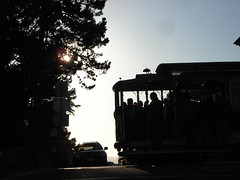You may have seen in the news or elsewhere about Lonely Planet‘s recent declaration of their top ten cities, regions and countries for 2011. All the lists are in Lonely Planet’s new book Best in Travel 2011, which has just been published.
 There are some good headlines for Scotland: Shetland (see right) is in the top ten regions, Edinburgh is in the top ten artistic hot-spots and Glasgow is in the top ten comeback cities.
There are some good headlines for Scotland: Shetland (see right) is in the top ten regions, Edinburgh is in the top ten artistic hot-spots and Glasgow is in the top ten comeback cities.
Anyone’s view of their top tens is going to be highly subjective, and if the publishers resorted to deciding any of these by committee then it will make an even more unreliable set of lists. Furthermore, if a place on a list is relatively “undiscovered” yet easy to get to, then it might get swathes of visitors that undermine some of the reasons that got it on to the list in the first place.
However, as is the case with these “opinion” lists, they’ve generated all sorts of discussions in newspaper articles, blogs and so on, and any discussion about good places to travel to has to be a worthy bandwagon, so I hereby jump on.
First up, I’ve not bought the book so haven’t seen the full list of categories, so perhaps I’ll limit my comments to the three categories I link to at the top of this article on the Lonely Planet website.
 In terms of the top ten regions, I can vouch for four of them – Sinai, Istria, west coast USA and Shetland are all great, although whether the west coast of the USA counts as a “region” on the same level as the others I am not sure. It’s a bit too big to be singularly quantified or compared, but I certainly enjoyed my two-week road trip there in 2008 (see left). And you can read all about that in my second book.
In terms of the top ten regions, I can vouch for four of them – Sinai, Istria, west coast USA and Shetland are all great, although whether the west coast of the USA counts as a “region” on the same level as the others I am not sure. It’s a bit too big to be singularly quantified or compared, but I certainly enjoyed my two-week road trip there in 2008 (see left). And you can read all about that in my second book.
Shetland is somewhere I’ve raved about before and so won’t bother labouring the wonders of one of my favourite parts of Scotland (though here’s one post from the archives and one set on Flickr), while the mention of Patagonia and Iceland among the regions I’ve not been to, just whets my appetite for further trips. Iceland is definitely at or near the top of my want-to-go list, and hopefully one day will make it.
Top of the countries list is Albania. That’s a surprising one, but definitely one I’d agree with. It’s a country that’s slowly but surely developed since its horrible post-communism economic collapse. The country had an awkward birth as a modern democracy (it’s condition in the mid-90s brilliantly described in Robert Carver’s The Accursed Mountains: highly recommended reading for anyone going to Albania and wanting to understand a little about the place). Over my three trips to that beautiful, compelling country I’ve seen positive changes, not least improvements in infrastructure that will make tourism that bit easier. I’ve not been since 2003 – no doubt it would be unrecognisable, mostly for the better, if I was to return. Which I hope I do.
Italy is perhaps a cliched entry, and my experience of it is limited to motorways (to me, it’s just one of those places you drive through to get to Albania), but Syria definitely jumps out as somewhere I’d like to go. Ever since bumping into some Syrian sailors in a Slovenian port town (not as sordid a story as it sounds), I’ve had a really good impression of the country – packed full of Biblical and other history, warm and welcoming people, and amazing scenery, and a world away from the pariah status accorded to it by most of the west.
And as for cities, I’m intrigued by the inclusion of Newcastle, Australia. A moderately pretty but lifeless and uninspiring place, I wonder whether one of the list authors came from there and allowed a little bias to influence their decisions! New York, Wellington and to a lesser extent Tel Aviv are cities I’ve very much enjoyed, though the list reminds me that Ghent is one of the places in Belgium I’ve not yet seen but heard great things about.
Which reminds me: Belgium. Definitely in my top ten countries. Like Germany, anywhere that has a culture based on beer, sausages and chips has to be doing something right; and the people and architecture aren’t too shabby either.
Of course, these top ten lists are not all about what’s absolutely best (even if that could be agreed on), but what’s emerging or hot for this coming year. It’s one way, I guess, of rewarding places that are up and coming, improving or ready to break from hidden gem to mainstream tourist destination, and so in a sense goes some way to answering the question of how they can judge places.
But it’s all still entirely objective. And surely therefore all the more fun to discuss.



Or, more likely, the lists are about spreading conversation-starters all over the world to attract free publicity everywhere. The UK press will pick up on Shetland, Australia Newcastle etc. etc. It’s probably just good marketing for Lonely Planet to gonunusual or controversial. It doesn’t matter if they sell any copies of this book, as 1000 newspapers have jest written an article prominently mentioning them…
Undoubtedly Lonely Planet’s publicity has been clever, targetting particular stories about the lists to certain areas. It’s the same whenever a new Lonely Planet guide to Scotland comes out and there’s the same round of outraged local councillors complaining about Glasgow being portrayed as dangerous, Aberdeen as grey, and so on.
That, I suppose, reinforces the subjectivity of it all because it can be even less reliable or authoritative as a list. It’s still going to get people talking though.